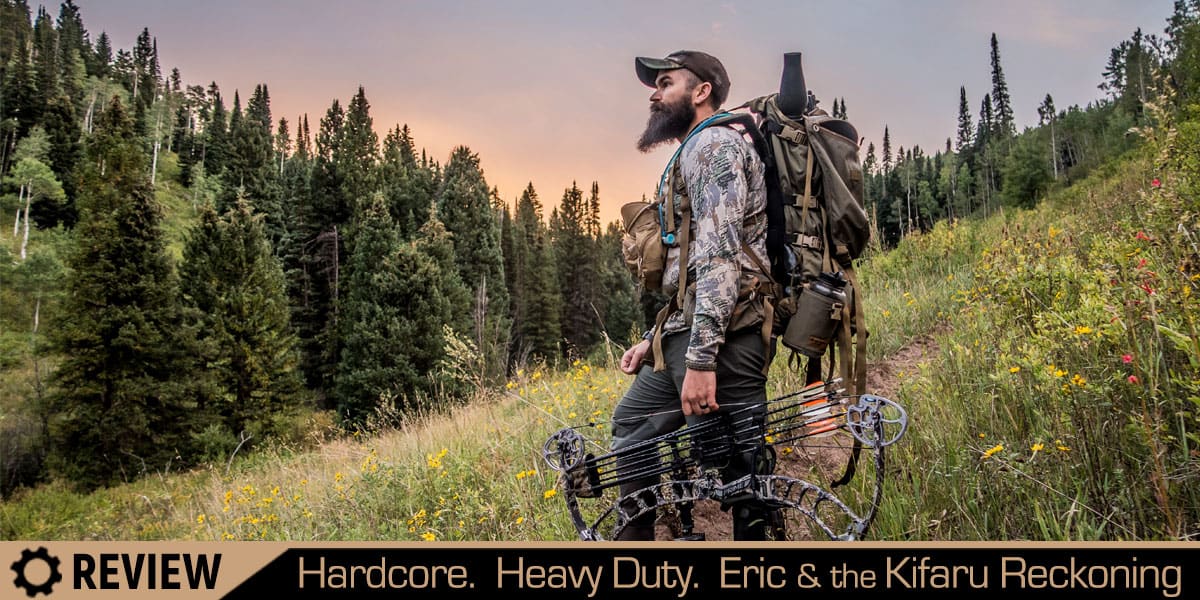
Kifaru-Reckoning-Review
There was a moment more than two years ago when I’d finally had enough. I’d spent over a decade lugging gear and meat around on my back with whatever box-store special backpack or frame pack I could get my hands on, and as a result was no stranger to sore shoulders and an always aching lumbar region. On this day, some 10 miles deep in the timber country of Washington state during a grueling muzzleloader Roosevelt elk season, something in me snapped. Maybe it was the fact that I’d been grinding out a dozen miles a day for a week with one of the least comfortable packs on the planet, a poorly made yet fairly expensive brand-name setup that I later tossed in a junk pile. Maybe it was the fact that my back was as sore as it’d ever been, despite being in relatively good shape.
After spending hours researching and talking with friends and fellow hardcore backcountry hunters, my decision to buy a quality backpack with customizable fit and modularity really came down to two brands: Stone Glacier and Kifaru. I was looking for a pack that was fully capable of hauling 100 pounds or more of hunting gear and meat and was versatile enough to handle hunting trips from a day to a week in length. I decided to go with Kifaru’s Reckoning because of its extreme modularity, customizable design, and rugged dependability.
What the AR-15 offers shooters by way of modularity, Kifaru offers to hunters and warfighters with its legendary packs. The Denver-based company’s pack system is built around an incredibly rigid, lightweight frame, either in a standard Duplex (Hunting or Tactical) or Lite/Ultralite platform. The standard Duplex frame is more rugged, offering a bit more padding and weight (3 pounds, 8 ounces) than the Lite frame (2 pounds, 14 ounces). To accommodate different body types, the frame is available in three lengths: 22, 24 and 26 inches. The frame allows you to attach a Kifaru bag system of your choosing, or remove the bag and simply run a minimalist meat hauler with various accessory bags of your choosing. The pack frame includes sternum strap, shoulder tightening straps, and waist stabilizing straps, all of which make for an incredibly snug fit and limited pack movement when hauling heavy loads.
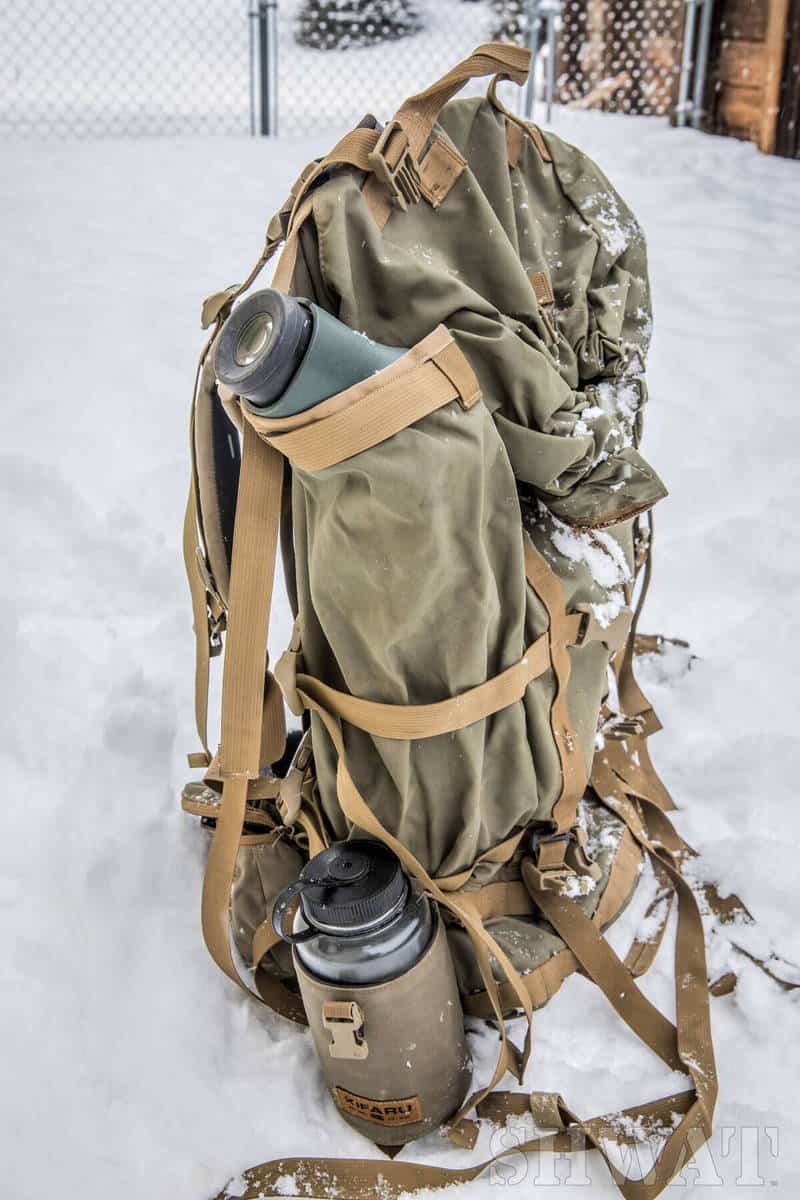 The waist belt features K-clip attachment points for a handgun holster, one-hand zip pouches of various sizes, or water bottle holder. The belt itself is well padded and ergonomically designed to ride on the hips, while a sturdy plastic buckle cinches down tight but doesn’t dig into your stomach. While sizes on the belt range from extra small to large, Kifaru will build you a custom belt length if necessary, which is especially handy if you’re in between sizes.
The waist belt features K-clip attachment points for a handgun holster, one-hand zip pouches of various sizes, or water bottle holder. The belt itself is well padded and ergonomically designed to ride on the hips, while a sturdy plastic buckle cinches down tight but doesn’t dig into your stomach. While sizes on the belt range from extra small to large, Kifaru will build you a custom belt length if necessary, which is especially handy if you’re in between sizes.
After selecting your frame, the next step is to choose a main bag that fits your needs. I chose the Reckoning (2 pounds, 13 ounces), one of Kifaru’s newest models, because it can be expanded from 5,000-6,000 cubic inches, is ideal for weeklong hunts deep in the backcountry, or can be strapped down when empty to make for a very manageable daypack. With additional accessory pouches and Guide Lid, the Reckoning puts you at about 7,500 cubic inches, which gives me ample room for camera equipment, hunting gear, tripod, spotting scope and a week’s worth of food.
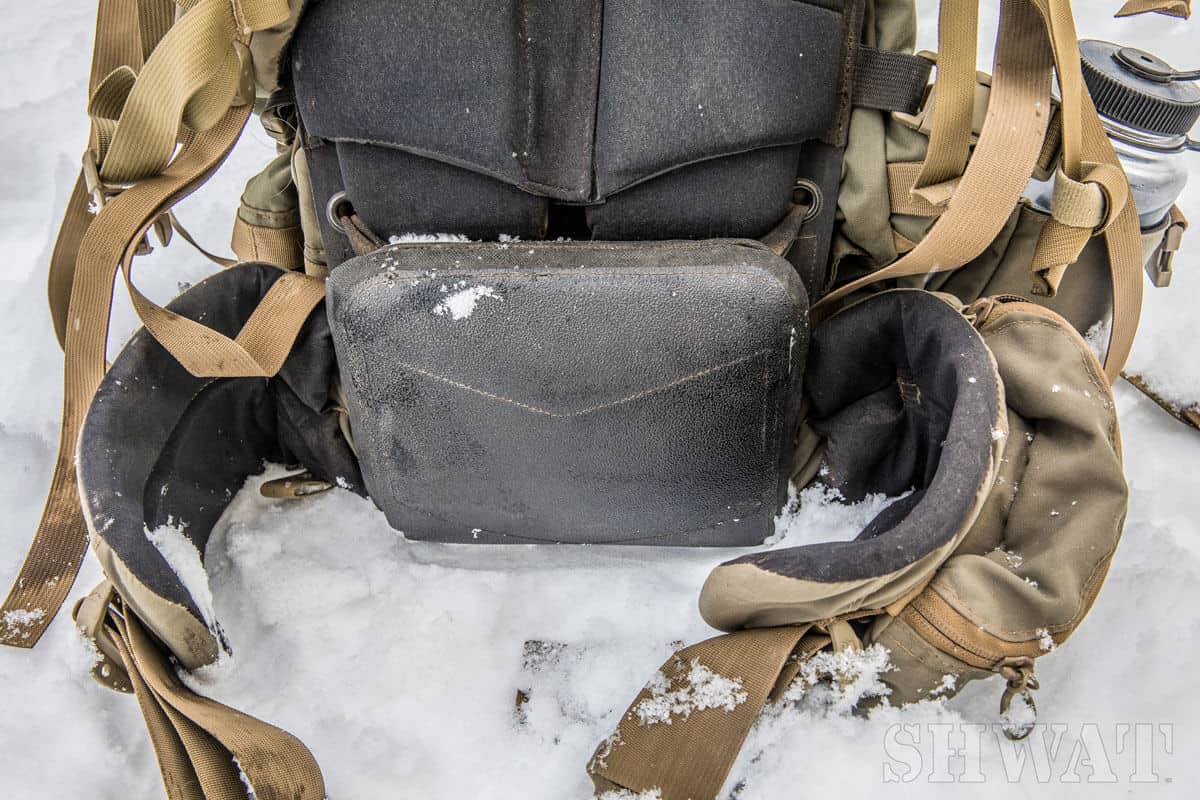 Since most of my hunting consists of one- or two-day trips, I frequently put essentials in my waist belt pouches and Guide Lid and used the main pocket for meat hauling. When used in this manner, the main bag is capable of hauling an entire rear quarter of an elk or the meat from two mountain goats. If you have your main bag stuffed with gear, there’s also a meat shelf that can be expanded to fit a game bag and quarter in between the main bag and pack frame. Because it is removable, the main bag can be easily washed after a bloody packout.
Since most of my hunting consists of one- or two-day trips, I frequently put essentials in my waist belt pouches and Guide Lid and used the main pocket for meat hauling. When used in this manner, the main bag is capable of hauling an entire rear quarter of an elk or the meat from two mountain goats. If you have your main bag stuffed with gear, there’s also a meat shelf that can be expanded to fit a game bag and quarter in between the main bag and pack frame. Because it is removable, the main bag can be easily washed after a bloody packout.
The Reckoning bag comes with a small removable zipper pocket inside the main bag and features side and center straps that operate independently of each other. This means you can cinch down either of the two side storage pockets (external top access) or the central bag separately. The two outside pockets are roomy; I usually stuff a tripod in one side and a 95mm spotting scope in the other. Conveniently, the outside straps feature a self-locking tab to keep them from loosening when you’ve got a hundred pounds of meat or gear on your back. An extremely heavy-duty dual zipper runs down the center of the main bag, allowing you to open from top or bottom for easy access of gear.
Accessorize Yourself
One of the beauties of the Kifaru pack system is that it’s highly modular and customizable. You can add multiple zippered pouches to the waistbelt or to the main bag, as well as gun holsters or Nalgene water bottle holder. At the center bottom of the Reckoning bag is a handle that can either be used to load the bag into a vehicle or float plane or to carry a compound bow—the cam fits inside the handle and allows you to tighten down the bow with the bag straps.
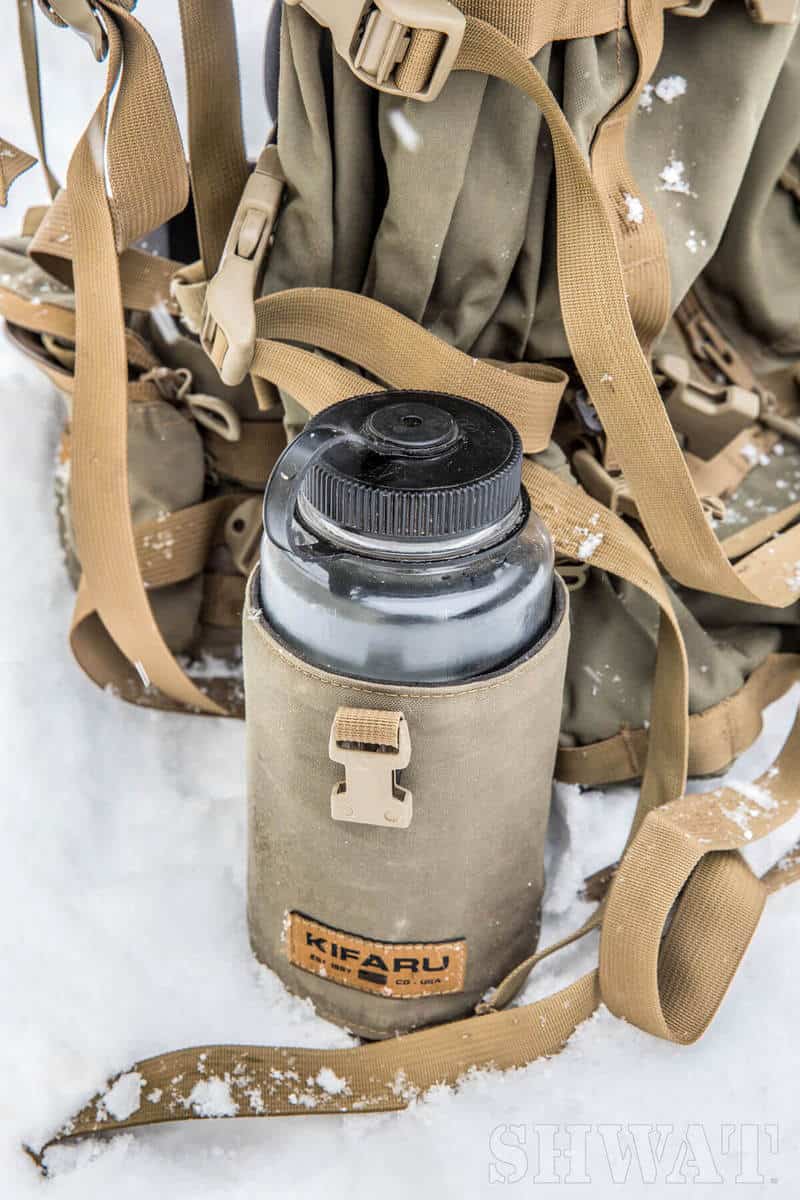 I run my bag with a medium size belt pouch (there are three sizes, from 2.5 to 3.5 ounces) on the left side, which holds my GPS and any other items I need rapid access to. It features a zipper that can be opened or closed with one hand. Also on the left side is a Nalgene holder that can be accessed without removing the pack. On the right, I attach a handgun and spare magazine holster, ideal accessories for hunting in bear country.
I run my bag with a medium size belt pouch (there are three sizes, from 2.5 to 3.5 ounces) on the left side, which holds my GPS and any other items I need rapid access to. It features a zipper that can be opened or closed with one hand. Also on the left side is a Nalgene holder that can be accessed without removing the pack. On the right, I attach a handgun and spare magazine holster, ideal accessories for hunting in bear country.
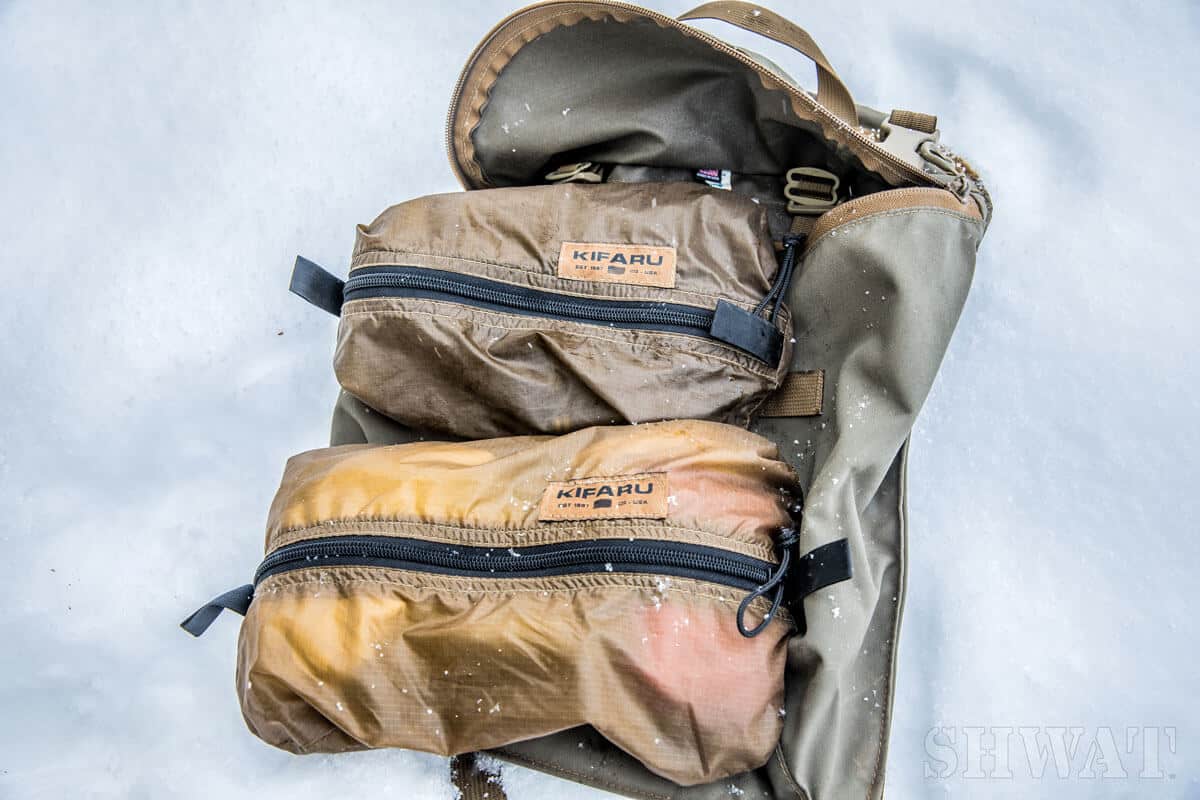 Kifaru also sells pullout bags of various sizes that are extremely handy for organizing gear. You can purchase them in 500D or ultralight material to save weight. I rely on the pullout bags to make transitioning from hauling gear to offloading it at camp and getting ready for day hunting quick and painless. Because gear is organized by bag, things like food and spare clothing get dropped in a tent while first aid kits and daily rations of food stay in the pack. This saves time and keeps me better organized throughout the trip.
Kifaru also sells pullout bags of various sizes that are extremely handy for organizing gear. You can purchase them in 500D or ultralight material to save weight. I rely on the pullout bags to make transitioning from hauling gear to offloading it at camp and getting ready for day hunting quick and painless. Because gear is organized by bag, things like food and spare clothing get dropped in a tent while first aid kits and daily rations of food stay in the pack. This saves time and keeps me better organized throughout the trip.
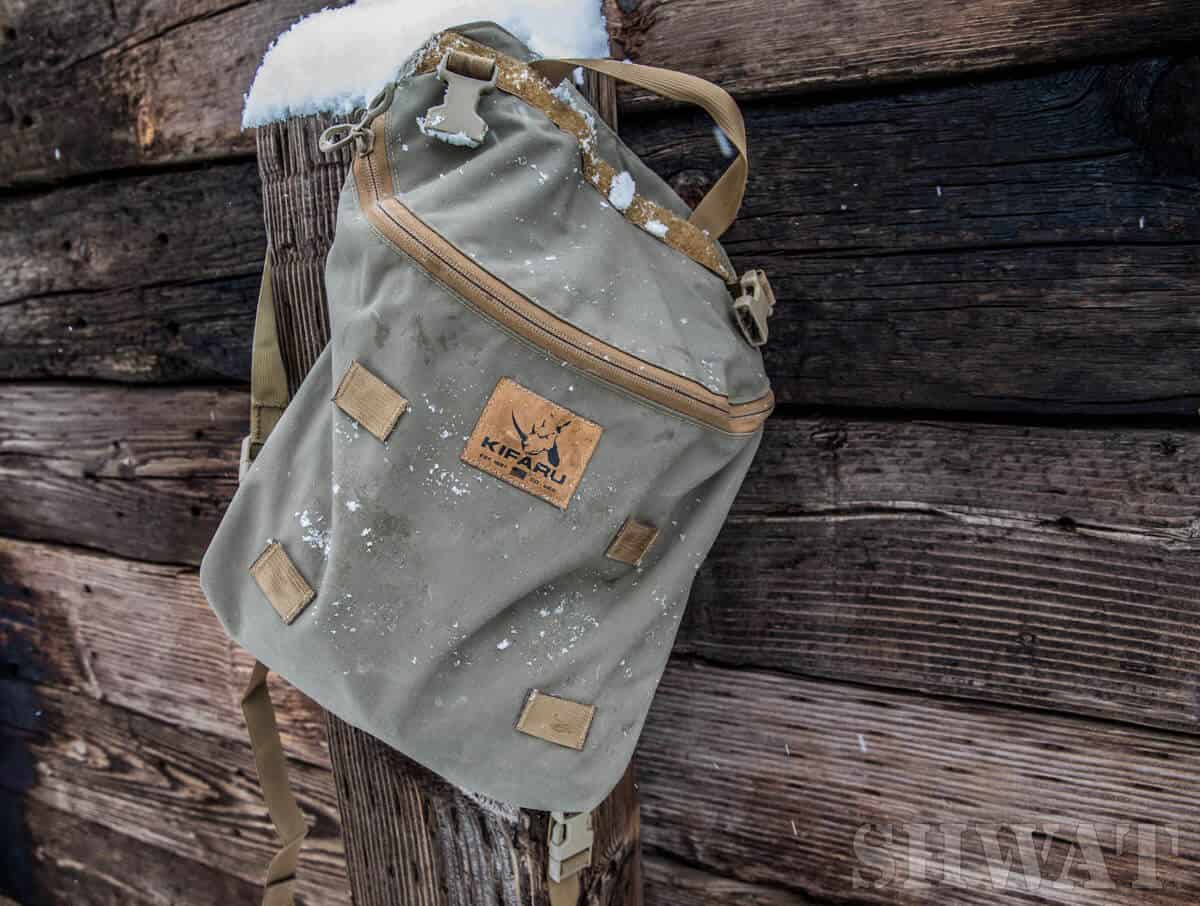
Kifaru’s Guide Lid
Finally, I’m a huge fan of Kifaru’s Guide Lid, which attaches to the top and bottom of the Reckoning bag. Most of the time I run the Guide Lid on top of the Reckoning and stuff it with anything I need for the day hunt. When it’s time to haul meat, I load the main bag with a quarter and keep my gear in the Guide Lid, which keeps it from getting blood soaked. When removed from the frame and main bag, the Guide Lid has straps and can be worn over the shoulders as a small day pack or camera gear bag. It offers 1,200 cubic inches of storage, which is plenty for a day’s worth of gear and food.
The other main accessory worth considering is Kifaru’s rain cover, which in my opinion is an absolute essential. It features a draw string to tighten around a bag of varying size and shape and is made of lightweight material. It stuffs down into a half-pint-sized bag. While most of the Kifaru pockets and bags are highly water resistant, the rain cover is necessary for days of wet snow or steady rain.
Field Tested, Hunter Approved
The first main test for the Reckoning last year came during Colorado’s archery elk season. After backpacking with it all summer, I took the pack out almost every day for a month, mostly on single-day excursions. Having covered hundreds of miles with the pack, I was impressed by the constant comfort, so much so that I consider it one of the best purchases I’ve ever made. It’s simply that much of a game changer. I had to save up for over a year to be able to afford it, but it was worth every penny.
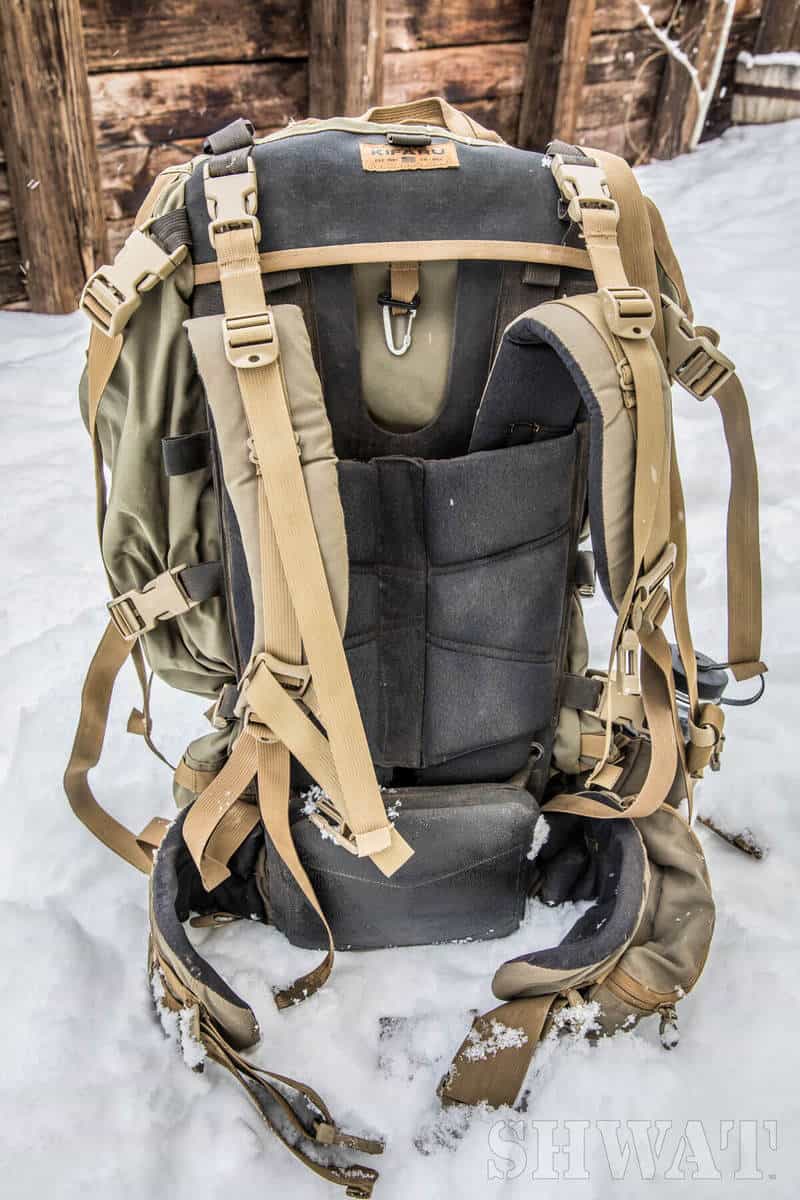
I ended up packing a bull out of a pretty gnarly hole with a friend and carried two hind quarters up and down some seriously steep Rocky Mountain country in the Reckoning. I didn’t bother with the meat shelf, but simply loaded the quarters into the main bag and dumped every non-essential at the vehicle. With trekking poles and good boots, it was by far the most comfortable packout I’d experienced. The legs were burning and the sweat pouring, but the pack lived up to the hype.
I packed out the meat from a friend’s black bear a month later, and then took the Reckoning on the ultimate test: a mountain goat hunt in British Columbia. After a half day spent hiking a snow-covered peak and over 2,000 vertical feet, my two friends each shot mountain goats. We skinned both goats and boned out the meat as the sun disappeared and the subzero temperatures sank into our bones. Our guide loaded his pack with one hide, and a little less than one goat’s worth of meat and a hide among the other two hunters. Each of us stared at the daunting pile of meat that remained. The guide asked if my pack could handle the weight, which he guessed at about 100 pounds (that didn’t count the 25 pounds of camera equipment and gear I’d brought).
“It’s not the pack that’s in question,” I laughed. “It’s my legs!”
The slopes were steep and dangerously slick with snow and ice, but we made it to the bottom without an issue. Once again, my legs were on fire as we traversed that steep mile and half back to the horses, but I wasn’t uncomfortable because of the pack. My shoulders and back felt fine, and there wasn’t any blistering or flesh gouging from the waist belt. The straps held tight, we avoided Grizzly bears and any nasty falls, and the pack performed like a champ.
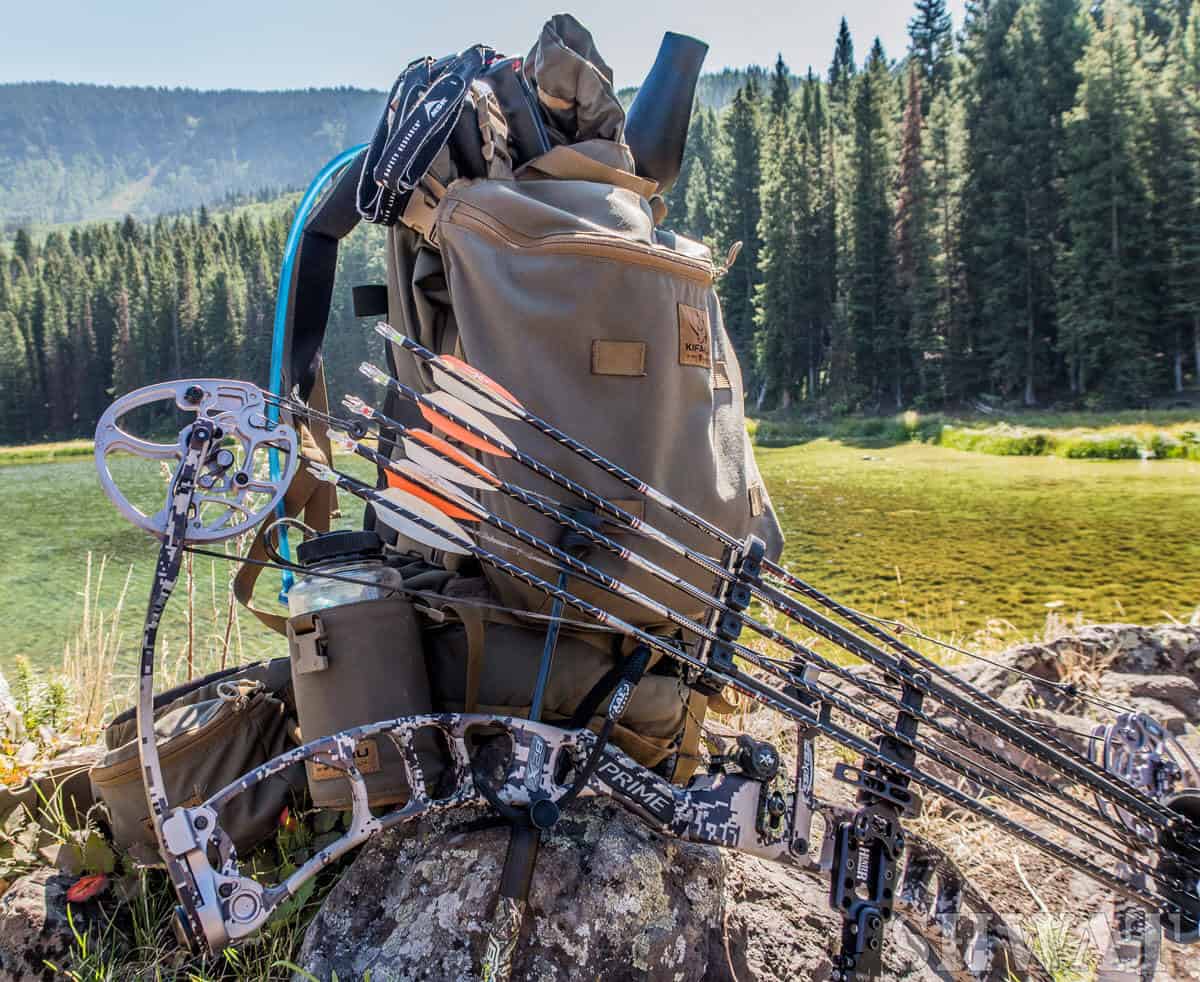 I’ve had at least minor complaints with every piece of gear I’ve ever purchased, but I can’t think of much to add to the negative column on the Reckoning. Aaron Snyder and the folks at Kifaru are hardcore hunters, so literally every design element has been engineered, tested, and modified from the perspective of the user. The price tag definitely isn’t for everyone—the Reckoning bag ($284) and Hunting frame ($376) easily put you over the $600 mark—but for the serious hunter carrying serious loads, it’s worth every penny.
I’ve had at least minor complaints with every piece of gear I’ve ever purchased, but I can’t think of much to add to the negative column on the Reckoning. Aaron Snyder and the folks at Kifaru are hardcore hunters, so literally every design element has been engineered, tested, and modified from the perspective of the user. The price tag definitely isn’t for everyone—the Reckoning bag ($284) and Hunting frame ($376) easily put you over the $600 mark—but for the serious hunter carrying serious loads, it’s worth every penny.
Kifaru Reckoning
Main Bag: 5,000-6,500 cu. in., 2 lbs., 13 oz., 11’’x37’’x12.5’’
Frame: Hunting, Duplex; 3 lbs., 2 oz., to 3 lbs., 14 oz.
MSRP: Frame ($376), Bag ($284), Guide Lid ($77); accessories vary
Manufacturer: Kifaru International; Kifaru.net


